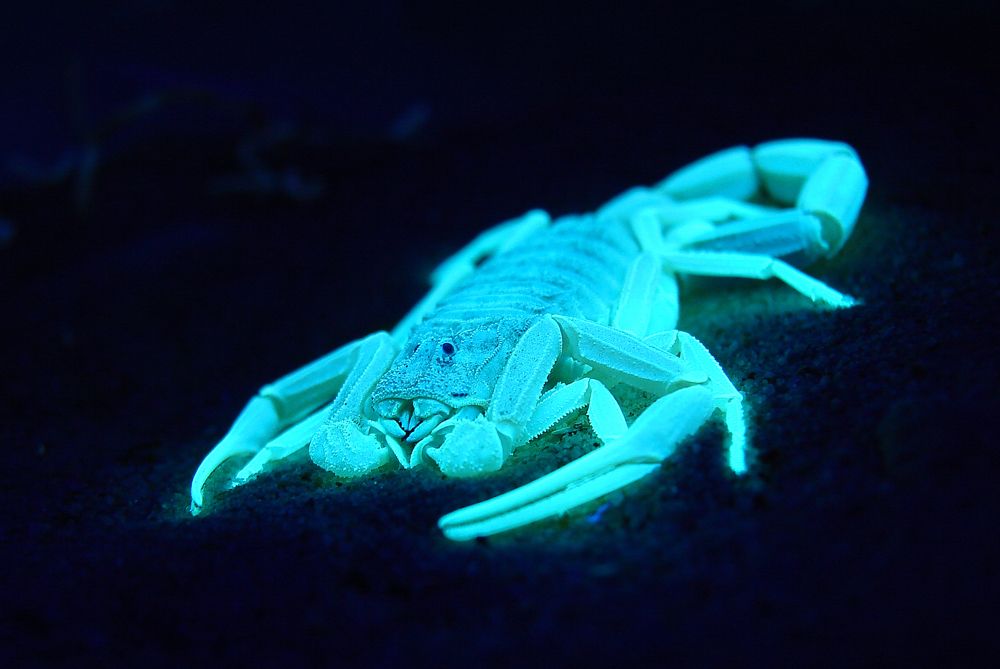Venomous Creatures #1: Deathstalker Scorpion
Introduction
Scorpions!!! the name terrified me when I was young. Movies made scorpions seem like the deadliest creature in the world, with just a sting, you are dead within few minutes. I had the believe that scorpions were as big as rabbits [hahaha, don't laugh me I was young] and were very dangerous, though, they are really dangerous but not as I believed then. Some weeks ago, I saw a scorpion in real life and it wasn't nearly as big as I imagined it to be all these years, I was shocked, I couldn't believe it until my brother made it clear to me. He told me of his bad experience of a scorpion sting, and how excruciating it was but he didn't die, then I got to understand that scorpions are not as big as and as deadly as I imagined them to be, though some are really deadly but are very few.
There are about 3,000 species of scorpions and only 25 are deadly. For this article, we will focus on Deathstalker scorpions which are among 25 species of deadly scorpions. You are already excited to know more, right? just relax yourself and continue reading this amazing article I made just for you.
_3.jpg)
Deathstalker Scorpion - Leiurus quinquestriatus
Deathstalker scorpion is the most feared and venomous member of the Buthidae family of scorpions. These deathstalker scorpions are also called Palestinian/Israeli yellow scorpion, Omdurman scorpion, Naqab desert scorpion and many other several names but it is best known as the Deathstalker Scorpion. It's scientific name is Leiurus quinquestriatus which can be translated into English as Five-striped smooth-tail
Deathstalker scorpions belong to the arachnid family and are a popular species in the North African and the Middle Eastern countries, which resulted to the two subspecies of Deathstalker scorpion;
Leiurus Quinquestriatus Hebraeus: These scorpions are found in the Middle Eastern countries such as Israel, Syria, Pakistan, Jordan, Iran, Yemen, Oman and others.
Leiurus Quinquestriatus Quinquestriatus: These scorpions are found in the North African countries, such as Algeria, Niger, Mali, Egypt, Libya, Somalia and others.
Scientific Classification - Kingdom: Animalia, Phylum: Arthropoda, Subphylum: Chelicerata, Class: Arachnida, Order: Scorpiones, Family: Buthidae, Genus: Leiurus, Species: L. quinquestriatus, Binomial name: Leiurus quinquestriatus (Hemprich & Ehrenberg, 1829) - Source
Wiki Commons - Licensed by CC-BY-SA-4.0
Deathstalker scorpions are nocturnal creatures, they prefer carrying out their activities in the night rather than in the day, in order to avoid the heat of the day. During the day, they stay in burrows below rocks or dig into the sand which help to keep them out of the harsh sun of the day.
Deathstalker scorpions are big scorpions measuring 80 to 110mm in length and weigh 1.0 to 2.5g. The females are bigger than the males because of their roles in reproduction. They have large pincers which are not that strong, and that's why they have a powerful venom which is used to quickly and effectively kill their preys. Scorpions' venom are not determined by their size or color but by their pincers. A scorpion with big pincer is less venomous than a scorpion with smaller pincer, reason being that, because of their small pincer, they wouldn't be able to capture their preys or defend themselves easily, so they depend on their powerful venom. My advice, if you see a scorpion with small pincers, either run!!! or kill it carefully, for me run!!! hahahaha.
Reproduction
Deathstalker scorpions are under the Buthidae family of scorpions that follows the Apoikogenic type of reproduction, which involves, embryos developing inside the female's ovary uterus and not outside on a different structure. The reproduction process of deathstalker scorpion is a complicated process which involves a lot of steps. In the reproduction process of this specie of scorpions, the female is in charge of deciding who she will mate with. The male scorpion must approach a female scorpion and grab her pedipalp chelea with his chelae fingers, performing a form of dance lasting for several minutes which is called Promenade a deux. After the dancing has stopped, the female will then decide if she wants to mate with the male. If she agrees, the male will then eject a spermatophore. After the male has ejected the spermatophore, he then arranges the female to where her genital opening will just be over the ejected spermatophore. The female would then, take up the spermatophore into her ovariuterus for reproduction of the embryos to start. After the reproduction process has ended, the male and female will separate.
The gestation period for a female deathstalker scorpion varies from 122 to 227 days, on an average of 185 days. The females give birth to about 12 to 87 scorplings, on an average of 62 scorplings. A definite number is yet to be known, reason being that, the number of scorplings are largely dependent on the size of the mother. The larger female scorpion, the more scorplings she is capable of giving birth to. But know this, the size of the mother, does not have any effect on the size of her scorplings. Once the scorplings are born, they crawl onto their mother's back where they will remain as a group for some few weeks, which helps them to regulate moisture in dry regions and protect them from predators.Feeding
Like all other scorpions, the deathstalker scorpions feed on small insects such as earthworms, crickets, centipedes and sometimes they engage in cannibalism i.e feeding on other scorpions. Deathstalker scorpions are capable of detecting vibrations with the use of their sensory hairs which are found all over their legs. These sensory hairs help them to detect vibrations, which they use to capture their preys in the dark. If you can recall, you know I said that the deathstalker scorpions possess big pincers. They use their big pincers to capture, crush, weaken and subdue their preys and if the prey should try to fight back, they sting the prey to totally subdue it. After totally subduing their prey, they use their big pincers to bring it towards them and they eat it. That's how the deathstalker scorpions feeds, let's move on to their life cycle.
Life Cycle
Let's begin their life cycle with the birth of the scorplings. Scorpions, unlike the insects that lay eggs, give live birth like us humans. After the female scorpions have given birth to about an average of 62 scorplings, they create a birth basket by positioning their pedipalps and front legs to capture her scorplings. As I said earlier, for some weeks the scorplings stay on their mother's back for protection, which is an uncommon thing in the world of arthropods. As the scorplings grow, they shed their skin i.e molt and then leave the protection of their mother's back. The scorplings continue to molt and grow for years until they become adults. Deathstalker scorpions generally undergo the process of molting at least 5 times before becoming an adult and then start the life cycle over again. The average life span of a deathstalker scorpion is 2 to 6 years.
Fluorescence
Do scorpions glow under ultraviolet light at night? Yes, they do. All scorpions in the world, react to the ultraviolet light. The darker they are, the brighter they glow. The blue-green glow comes from a substance found in the hyaline layer of scorpions' exoskeleton which is called the Cuticle. It is known that after a scorpion molts or sheds it's skin, it does not glow until the new cuticle hardens. Some scorpions experts however believe that the scorpion fluorescence has no purpose while some others have pointed out the usefulness of scorpions fluorescence, which are;
- It benefits us humans as we can easily identify them in the dark, in order to avoid them or study them.
- It might be used to confuse their preys.
- It may also be used to find themselves in the dark.

Deathstalker scorpoin's Venom
Deathstalker scorpions are known as one of the most dangerous species of scorpions in the world because of it's powerful venom. Their venom comprises of high toxic mixture of neurotoxins including chlorotoxin, charybdotoxin, scyllatoxin and agitoxin, which can cause immense and excruciating pain. Deathstalker scorpions' venom can cause coma, fever, paralysis, convulsions, cardiovascular & respiratory dysfunction and even death, making it's venom one of the most toxic of any scorpion species. Despite it's terrifying reputation, a sting from a deathstalker scorpion is usually not life threatening for healthy adults, but that does not make the pain less excruciating(smiles). Although in the cases of sick, allergic, elderly, people with heart issues, or children, a sting could be life threatening.
As much as the venom seems to be very dangerous and fearsome, it has a bright side. Deathstalker scorpions' venom has shown some great potentials in the treatment of diabetes, cancer and human brain tumors.
Amazing Facts
- Scorpions are the oldest known arachnids.
- Scorpions can live for a full year without food.
- All scorpions are venomous but only about 25 species are know to have a venom capable of killing a human being.
- Scorpions have poor vision despite having 6 to 12 eyes.
- Females are usually larger than males. Sometimes, the females even kill and eats the males after mating.
- Scorpions do not chew their food, they dissolve the tissues of their prey with digestive juices and aspirate the nutrients in a semi-liquid form.
Thanks for reading
References
All images used in this article are free sources licensed under the Creative Commons and are liable for commercial use.
I'm a proud member of @air-clinic

I'm a proud member of @promo-mentors

I'm a proud member of @stach

I'm a proud member of @stemng

)
)
 )
Ever since I got stung by a scorpion in the middle of the night, I have read everything I can find about them. Truly, that sting wasn't life threatening, but the pain is something else.
This is very educating, I didn't even know about their fluorescence. Well done.
I never knew that these creatures are nocturnal.
Nice sharing this
Thanks for the info, I never knew they glowed in the dark
Thanks for reading through, I appreciate it. @atikajayboy
Interesting article,, I really enjoyed it.
Thank you for reading through and enjoying it @gabeman.
Awesome post!! Keep it up and check out THIS POST as well as I have something similar.
Awesome post!! Keep it up and check out THIS POST as well as I have something similar.
Congratulations! You have been upvoted by Graysque. Your post will be featured on our daily curation posts.
Our curation team is currently formed by @eddy-18, @jo5h, @chinyerevivian, @biblio and @seesladen. We scout Steemit in search of excellent posts deserving more exposure and we believe your post is one of them.
Amazing post! I love it. Hey UPVOTE my post: https://steemit.com/life/@cryptopaparazzi/chapter-one-let-there-be-the-man-and-there-was-a-man-let-there-be-a-woman-and-there-was-sex and FOLLOW ME and I ll do the same :)
Amazing post! I love it. Hey UPVOTE my post: https://steemit.com/life/@cryptopaparazzi/chapter-one-let-there-be-the-man-and-there-was-a-man-let-there-be-a-woman-and-there-was-sex and FOLLOW ME and I ll do the same :)